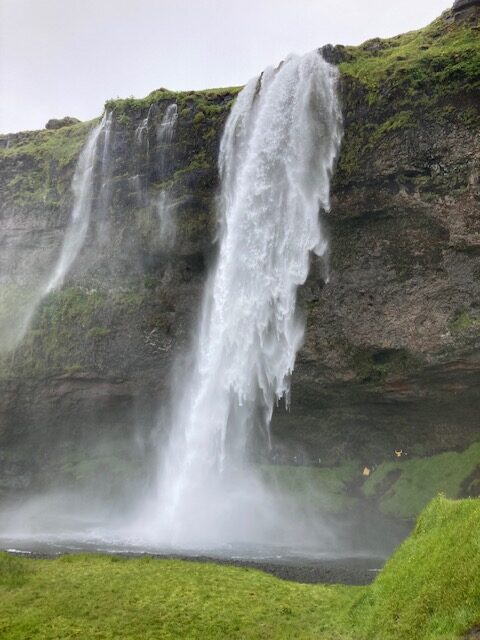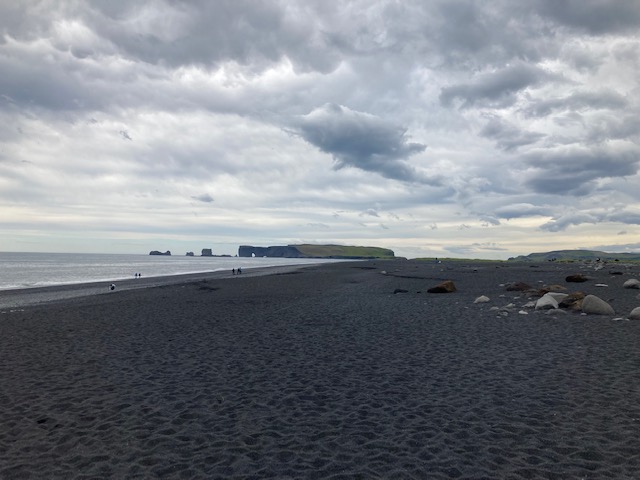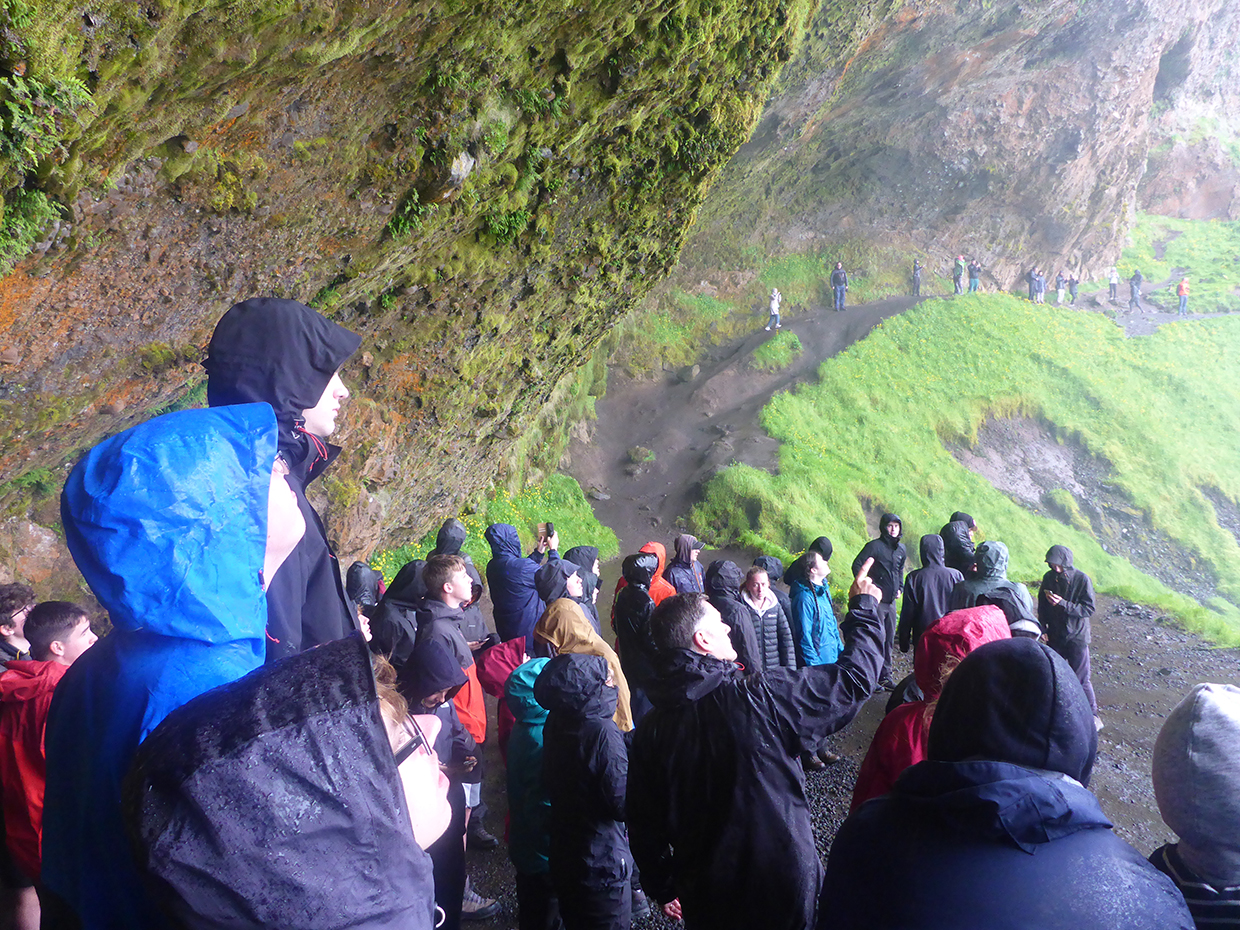 KS4 Geography Students Enjoy Their Iceland Field Trip 2022
Published on 8th July 2022
KS4 Geography Students Enjoy Their Iceland Field Trip 2022
Published on 8th July 2022
Our KS4 & 5 Geography students embarked upon a Field Trip to Iceland last week. Deputy Head Mr Allmand, also a Geography teacher at College, wrote a daily blog while ‘on tour’:
Travel challenges!
Field trips are designed to try and give students experiences that they have not had and maybe will not experience in a long time.
However, 11 hours in an airport terminal was not something that was planned, but will certainly live long in the memories of students and staff.
Everyone coped admirably with their time in and out of the full array of shops and eateries and were ultimately glad to board the Icelandair flight just before 9pm.
The Tom Hanks film, The Terminal, was starting to feel like it might become a real possibility at one point, however, the ‘bing bong’ of the boarding announcement brought relieved smiles to the faces of everyone.
A post midnight arrival to the hotel meant everyone went straight into their rooms to try and get to sleep in the semi-gloom that constituted an Icelandic summer night.
Day 1
Breakfast this morning was at 8am and we were greeted by a beautiful blue sky over the Hotel Ork.
And so a full day of activities ensued…
A leisurely ‘dip’ in the Geothermally heated pools of the Secret Lagoon eased everyone in and we careful to respect the houses of ‘the little people’ – it is worth a quick internet search on Iceland and their respect for elves and the like – or to gain a Will Ferrell perspective on this you could watch the recent film Eurovision.
Following the tourist activities associated with geothermal areas we moved on to Gullfoss.
This is a spectacular 2 drop waterfall and the sheer power of nature can be experienced from some fantastic vantage points.
Students were encouraged to look out of the window at nature, so hopefully the images of ice caps, ice sheets, fumaroles, volcanoes, glacial rivers, plus the unimaginable number of Icelandic horses will have made lasting memories!
A second geothermal area followed and a short stop at Geysir enabled the students to see the regular eruption of the Strokkur Geysir.
Thingvellir National Park is a truly remarkable place and as well as being the site of the world’s first parliament in 930ad, is ‘the line on the map’ that most Geographers have drawn at some point when locating the Mid Atlantic ridge on a map.
The bus moved swiftly from the Eurasian plate, through the sinking rift valley over to the North American plate. The students were able to walk through some of the huge tears in the earth’s crust and while nothing appeared to be moving – the nature of a constructive plate margin like this means that the power of what is happening (or is about to happen) just beneath your feet is phenomenal.
The students came to Iceland to see their text books (or google pages) brought to life and there are very few places in the world where so many concepts can be covered in 8 hours.
The final visit enabled the pupils to walk around the rim of an extinct volcano and to descend into the floor of the crater.
So….when you ask what they did on their first day…and they say ‘Oh, a bit of this and that’, they were very very busy and have experienced a lot of real life Geography.
Time on the pool tables, table tennis tables, in the hotel pool or just chilling in their rooms is now the order of the day before another busy day on Sunday.
Day 2
Breakfast at 7.30am began our second full day and a number of pupils literally ‘filled their boots’ with the vast array of food on offer.
The interactive Lava Center was the first stop and many of the students commented on how pleasantly surprised they were with the quality of the displays and the high class film show that showed what a truly dynamic place Iceland is.
There followed a short trip to the Seljalandfoss waterfall and everyone donned their waterproofs and walking boots and heeded the Bon Jovi – Slippery When Wet – warnings and proceeded around the back of this incredibly impressive feature.
Waterfalls would normally occur near the source of a river, I wonder if they remember why this one occurs very close to the sea – maybe this could be a topic of conversation over the dinner table one evening.
Having emerged from the back of the waterfall slightly damper than when they went in, the students shook themselves down and boarded the bus for their first shopping adventure.
A trip to the most southerly town, Vik, enabled the students to supplement their lunch from the various food outlets and realise that Icelandic prices for clothing items are significantly more than those at Cheshire Oaks.
A short trip to the world famous black sand beach at Reynisverfi allowed the pupils to revise or learn about coastal Geography and the dangers that some beaches pose to those tourists who chose to ignore all the waning signs.
Discussion topics included, caves, arches, stacks and stumps, longshore drift, fetch, columnar basalt, tombolos, wave refraction and many other topics that those of you reading might remember from your own GCSE (or O Level) and A Level studies.
Today’s drive back along the coast enabled the students to view the Vestmannaeyjar Islands and learn about their incredible volcanic history, what might happen if the volcano Katla erupts and how you can create a tourist honeypot site from a downed US DC10 aeroplane!
A brief stop at the shrinking Solheimajokull glacier provided the backdrop for a discussion on climate change.
Many of the landscapes that so many of you will have enjoyed in The Lake District and Snowdonia have been formed as a result of climate change over the last 20000 years and so, and as the GCSE and A Level syllabuses dictate, we were reminded that glacial shrinkage (retreat) is cyclical and has enabled us all to enjoy some magnificent UK landscapes.
Our visit to a Geothermal power station tomorrow will remind us what more we can do to counteract the ‘enhanced’ greenhouse effect that scientists say we are now experiencing.
Skogafoss was our last stop and most tested the label ‘waterproof’ on their coats and trousers. Having the ability to feel the sheer power of nature up close and personal is something that most will not forget and a dip in the hotel pool, games of uno and chess, and chance to relax provided a perfect end to another busy day.
Day 3
Geography teachers love being outside, talking about Geography and trying to inspire others to become enthusiastic custodians of planet earth.
The passion for their subject and amount of material covered over the last few days might have surprised one or two students, but then, they signed up for a Geography trip, and Geography is exactly what they have been immersed in from the start to the end of each day.
A visit to a Geothermal Power Station began today’s activities (a first for many/most) and what made the staff smile, and proud that they are inspiring the next generation, was when students came up to us to ask ” yeah, but what about….” and “so why don’t they….”.
Field trips can be an assault on the senses and the second visit tested the sense of smell of everyone.
The students could detect the sulpherous emissions of the the bubbling geothermal pools long before they could see them.
Until interactive headsets are developed that provide a ‘complete experience’, Geography field trips, in person, will remain the best way to truly get to grips with landscapes and their formation – and the tourist opportunities that seem to endlessly present themselves.
We moved on, and as we tracked the current seismic activity in the area, we visited the cooling lava flow from the 2021 eruption.
‘Tourism’ here was how a few of us remember other locations being not that long ago…a bit of a gravel road, a dusty car park, some handwritten direction signs, a few basic facilities and not very many people.
We were able to move away from the few people who had made it to the site and the vista for lunch has to be one that not many can say that they have ever had.
How long before a tarmac road, pay and display car park, cafe, gift shop and viewing platform, enable mass tourism to get a hold in this landscape as well?
Our postponed visit to ‘The Bridge Between The Continents’ followed and students were able to move quickly between the Eurasian Plate and the North American plate whilst wondering what the land in the middle was part of (North America is on the left)!
A trip to the most northerly capital city in the world followed.
Culturally and historically, Reykjavik is a fascinating place, and while we only had a couple of hours to explore a few key locations, we hope that we have inspired a few students to want to return – maybe to bring their friends and relatives – and to develop and pass on their new found love for a diverse and fascinating country.































